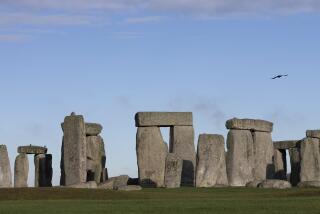Dig Sheds New Light on Mysterious Aztec Culture
- Share via
MEXICO CITY — Archeologists call it one of the most important finds of the Aztec culture--a huge, circular-shaped carved stone used for human sacrifice.
“It was a sacrificial stone with a double function, used both to celebrate a war victory upon which the Aztecs sacrificed a captured warrior, and for human sacrifice during religious rites to the sun god,” said Guillermo Perez Castro, coordinator of the archeological dig.
The stone, believed to date from about 1460, is still in a gaping square hole smelling of freshly dug earth in the middle of a Spanish colonial courtyard at the heart of the former capital of the Aztec empire.
Around its perimeter are 11 scenes depicting conquests of 11 tribes by Aztec warriors. In each, an Aztec warrior costumed like a god is shown holding a captured prisoner by the hair.
“In the Mexica (Aztec) religion, the primary god, the sun god, was believed to be nourished by human sacrifice,” Perez said. “In order for the sun to rise, the sun god had to be fed by the blood and the hearts of humans.”
On this stone, the heart of a bound prisoner from a conquered tribe was carved from his chest while he was still alive and the heart still beating.
The heart was put into a center hollow, representing the mouth of the sun god. From it the blood flowed in rivulets, defining the etched rays of the sun in red and animating the symbols of stars, eagle feathers and water, Perez said.
The chance find of the 8- to 12-ton volcanic stone monolith, nearly 3 feet thick and 7 feet in diameter, could throw new light on the mysterious Aztec culture, archeologists said.
“This piece will give us greater and more exact understanding of this period of the Mexica,” said Pedro Francisco Sanchez, chief archeologist of the National Institute of Archeology.
“This piece is extremely important. I believe it is one of the most important found from the Mexica culture, definitely,” Sanchez said.
The Aztecs founded Tenochtitlan, where Mexico City now stands, in 1325. This marked the beginning of an empire that flourished for nearly 200 years, until the Spanish conquest in 1521.
Because the conquistadors demolished Tenochtitlan and constructed their city on top of its rubble, much of the Aztec culture still remains buried under Spanish colonial buildings in the center of Mexico City.
On June 27, two archeologists from the National Institute of Archeology, Maria E. Judith Padilla y Yedra and Antonio Gudino Garfias, began routine excavations to investigate the cracking foundation of an 18th century building now used as finance ministry offices. On July 1, the stone was discovered in the building’s courtyard.
“Gudino was the first to spot a piece of the stone and said it was part of a sculpture that possibly was an owl, because of the circular water symbols, which he took for eyes,” said Padilla y Yedra.
“We weren’t sure at first how important the find was, but now we’ve become immortalized,” Gudino said.
Sanchez said cracking foundations are often an indication of archeological material beneath. Cracks usually mean that the foundation is not evenly based and suggests that something is underneath the building, Sanchez said.
“We engage in archeological excavations, which help to find out what is happening to the foundation of a historic building and it enables us to recuperate part of our history,” Sanchez said.
He said that the stone is part of a temple to the war god Tezcatlipoca, and that it is highly probable that more of the temple is underneath.
“What interests us very much about this excavation is to find out if the stone is in its original place,” Sanchez said.
The archeologists are interested in defining the exact period of the stone, conserving it so that it doesn’t lose its red pigments, restoring it and “then interpret as precisely as possible the meaning of all of its symbols before moving it to a museum,” Sanchez said.
Sanchez said a similar stone in the famous National Museum of Anthropology possibly is from a somewhat later period, since it depicts four new scenes of conquered tribes besides the 11 found on this stone.
No more than 10 such stones have been found from the Aztec culture, Sanchez said. He ranked this as among the five most important stone monoliths ever discovered, along with the famous Aztec sun calender, which also is in the National Anthropology Museum.
More to Read
Sign up for Essential California
The most important California stories and recommendations in your inbox every morning.
You may occasionally receive promotional content from the Los Angeles Times.













